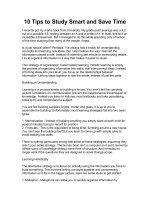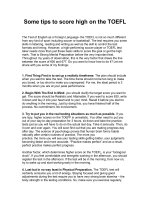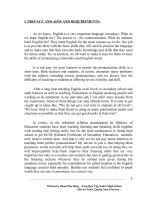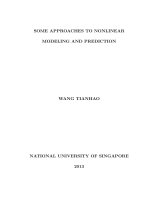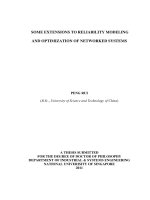Some tips to pronounce ses and ed effectively
Bạn đang xem bản rút gọn của tài liệu. Xem và tải ngay bản đầy đủ của tài liệu tại đây (116.53 KB, 18 trang )
THANH HOA TRAINING EDUCATION DEPARTMENT
TRIEU SON 5 HIGH SCHOOL
EXPERIENCE INITIATIVES
SOME TIPS TO PRONOUNCE:”-S / ES AND – ED”
EFFECTIVELY
Author: Le Thi Ngoc Ha
Position: Teacher
Experience initiative in the field: English
SCHOOL YEAR: 2016 - 2017
1
TABLE OF CONTENTS
1. INTRODUCTION
page
1.1. Reasons for choosing the topic………………………………………… 2-3
1. 2. Aims of the
researching………………………………………………......3
1. 3. Object to research this
topic……………………………………………...3
1. 4. Method to research this topic. ………………………………………… 34
2. MAIN CONTENTS
2.1. Rationale………………………………………………………………...4-8
2. 2. The status of learning English in Trieu son high school No5……...........8
2. 3. Proplem solving………………………………………………………9 -15
2. 4. Research results ………………………………………………………...15
3. CONCLUSION
3.1. Conclusion………………………………………………………………..16
3. 2. Sugession………………………………………………………………...16
2
1. INTRODUCTION
1.1. Reasons for choosing the topic.
English becomes the most important language in the world. Almost all the
people from many different countries around the world use it to communicate.
The role of English is considered to be very important in the fields of culture
economics, education, politics and science. Especially, in the international
relationship, English speaking ability is very important to be able to participate
in the wider world of work.
The speaking skill is measured in terms of the ability to carry out a
conversation in the language. This reality makes teachers and parents think that
speaking ability should be mastered by their students and children. Based on the
reasons above, in recent years, English language teaching has focused on teach
the English language rather than teach about the English language. The
emphasis is not only on linguistic competence of the language learners but also
on the development of their communicative ability.
We say any word that means we are pronouncing it. Accurate
pronunciation is a must for any foreign language learner because the correct
pronunciation is that the listener can understand what the speaker is
pronouncing. If you mispronounce a word from the other will make the listener
misunderstood or not understood. And high school English textbooks have paid
much attention to this issue: Besides the skills section also has the pronunciation
was compiled in conjunction with the Language Focus grammar in order to
develop comprehensive skills to students.
However, the fact is that teachers do not have standard materials to teach
phonetics, so they have to research for their pronunciation. And especially on the
part of the students: pronunciation, they are not taught in a period that is only an
3
integral part of the language focus session. In a period that is both grammar and
pronunciation. Grammar section that grammar just a topic that sometimes two,
three themes (example: Unit 1- English 12: Tense revision: past simple; past
progressive; present perfect). Therefore, some teachers may have to go very fast
to teach grammar. And from this fact I have tried to help children learn through
some tips and multiple-choice exercises. Instead of remembering the phonemic
symbols and pronunciation of words. They only need to remember the adjectives
that are assigned to the bottom of the word "ed", "s / es".
By doing this, they are easy to remember and look at the quick answer to
this test. And this is also the reason why the topic: SOME TIPS TO
PRONOUNCE: “-S/ ES AND –ED” EFFECTIVELY is the subject of my
research.
1. 2. Aims of the researching.
As a teacher who teaches English subjects after many years of
teaching, I have learned to learn and apply various teaching techniques and have
drawn some experiences for myself. Teaches "-S / ES and -ED" pronunciations.
And when writing this initiative I would like to contribute a small part of my
teaching work in general. And specifically about teaching pronunciation to
students in particular to help them enjoy learning to improve their English and to
do good types multiple choice quiz phonetically: Find words that are pronouned
differently those from the rest.
1. 3. Object to research this topic.
- In my subject I focus only on focusing on the general theoretical issues
of pronounced "-S / ES and -ED". Such as: S / ES and -ED "appear where, rules,
how to read them. And finally, give the pronunciation tips, the corresponding
multiple-choice exercises to reinforce the basic knowledge to help students
understand the "ed" and "s" pronunciation rules in English.
- Students : 12a2, 12A4, 12A5.
1.4. Method to research this topic.
4
First of all, I use the knowledge I have learnt at university.
Secondly, I learn many experiences form my colleagues.
Moreover, I read many books to get the knowledge of the methods to teach
pronuncing. With all the knowledge I have collected I use them in teaching my
students pronuncing skills. After that, I choose methods which are suitabe for
my students. I use these methods many times and then they become my own
experiences. Now I am writing my own experiences in teaching pronuncing
skills in this material. Experimental and statistical methods (through practical
teaching combined with testing and evaluation).
2. MAIN CONTENTS
2.1. Rationale
In the high school English program, part of the pronunciation “ - ed”
and “ –s / es” was taught a little in unit 10 (Unit 11, Unit 10), focusing mainly
on Block 11. (Unit: 13,14,15,16) and review in block 12 (unit: 1,2).
- General theory: Last sound reading "s / es”
The final consonant "s" usually appears in Plural nouns and 3rd – singular verb
- There are three ways to pronounce the final consonant “ s / as” as follows:
If the noun or verb Noun or verb stem
Noun
ending is one of the
added: s or es
following sound.
/t/
/θ/
/k/
/p/
/f/
If the noun or verb
-sit
- month
- book
- stop
- roof
Noun or verb stem
ending is one of the
or
sits
-months
- books
- stops
- roofs
Noun or
/s/
verb
added: s or es
following sound.
/z/
/dʒ/
/s/
verb pronounced
pronounced
- recognize
- age
- bus
- recognizes
- ages
- busses
5
/∫/
/t∫/
- dish
- watch
- dishes
- watches
When the noun or Noun or verb stem
Noun
or
verb ending with is
added: s or es
/iz/
verb pronounced
the vowel and the
consonant remains
/b/
- cub
- cubs
/v/
- rob
- cave
- robs
- caves
/d/
- live
- bed
- lives
- beds
/g/
- read
- egg
- reads
- eggs
/l/
- dig
- hill
- digs
- hills
/m/
- fill
- room
- fills
- rooms
/n/
- come
- pen
- comes
- pens
/η/
- learn
- ring
- learns
- rings
/ou/
- bring
- potato
- brings
- potatoes
/lei/
- go
- day
- goes
- days
/e/
- play
- hair
- plays
- hairs
- wear
- wears
/z/
- General theory: Last sound reading “ed”
The "ed" appears in the verb with a division rule in the past tense or past
participle. The pronunciation "ed" as follows:
If the noun or verb Verb
The ending verb is pronounced
6
ending is one of the
following sound.
/t/
/d/
the 'ed'
- Start
- tarted
- wait
- waited
- Want
- Wanted
- paint
- Painted
- Expect
- need
- Expected
- Needed
- Attend
- Attended
- Add
- Added
- Land
- Landed
- Decide
- Decided
/id/
/
Some exceptions: Some words ending in-are used as adjectives, the -ed suffix is
pronounced / id /:
- Aged
- Lớn tuổi
- Blessed
- Thiêng liêng
- Crooked
- Cong
- Dogged
- Gan lì
- Naked
- Trơ trụt
- Learned
- Uyên bác
- Ragged
- Rách tả tơi
- Wicked
- Tinh quái
- Wretched
- Khốn khổ
- Devervedly
- Xứng đáng
- markedly
- Đáng chú ý
- supposedly
- Cho là
- allegedly
- Cho rằng
If the noun or verb Verb
The ending verb is pronounced
7
ending is one of the
following sound.
/p/
/f/
/s/
/∫/
/t∫/
/k/
the 'ed'
- step
- stepped
- stop
- stopped
- help
- helped
- Jump
- Cough
- Jumped
- Coughed
- Laugh
- laughed
- Stuff
- Miss
- stuffed
- Missed
- Dance
- Danced
- Fix
- Fixed
- Sentence
- Wash
- Sentenced
- Wased
- Brush
- Brushed
- Punish
- Punished
- wish
- Catch
- wished
- Catched
- Watch
- Watched
- March
- Marched
- Reach
- Ask
- Reached
- Asked
- Cook
- Cooked
- Talk
- Talked
/t/
/t/
When the verb is the Verb
The ending verb is pronounced
end and the remaining
the 'ed'
consonants
8
/b/
- play
- played
/g/
- open
- opened
- arrive
- arrived
- love
- loved
/v/….
/d/
2. 2. The status of learning English in Trieu son high school No5
The students I choose are students 12A2, 12A4, 12A5. These are the
three classes that I am teaching directly to study and demonstrate the topic of the
past. From the time I was assigned to teach these three classes I monitored their
learning situation.
Recognizing that the majority of students are less interested in
phonics because they are afraid to read because their pronunciation of the words
is not standardized and it is difficult to memorize the phonemic symbols for
them. As for the "ed" part, they do not remember when "ed" pronounced / t /;
When to pronounce is / id /; When to pronounce is / d /. In general, when they
have the word "ed", they either ignore the unread or all the "ed" are
pronounced / d / and the words "s / es" are almost pronounced. Is / s /. Because
of not read, not be pronounced so when the test results are not as expected as
follows:
Lớp
Sĩ số
Giỏi
Khá
Trung bình
Yếu
Kém
12a2
38
0
1
5
10
22
12a4
44
0
1
4
9
30
12a5
48
0
1
4
13
40
2. 3. Proplem solving
- Some tips to pronounce "-s / es ”
Group 1: "-s / es ” pronounced / t/ if before "-s / es” is the word:
9
ends with the
/t/
/θ/
/k/
/p/
/f/
sounds
Often end with
T
Th
K
P
f/gh
Tôi
Thề
Không
Phạm
fáp
the letters
Assigned word
Group 2: "-s" pronounced /iz/ if "-s" is the word:
ends with the sounds
/z/
/dʒ/
/s/
/∫/
/t∫/
Often end with the letters
z
ge
Ss, x, ce
sh
ch
Sháu
Chị
Assigned word
Zâng
Gé
Sau xe cé
Group 3: The case of rest (without memory)
(The teacher should guide students when they choose the "-s" ending in groups,
from group 1 to group 3 ".
- Some tips to pronounce "-ed"
* Words with the end "-ed": Students remember the following two groups:
Group 1: "-ed" pronounced / id / if before "-ed" verb
ends with the sounds
/t/
/d/
Often end with the letters T
D
Assigned word
dê
tái
Group 2: "-ed" pronounced /t/ if before the "-ed" verb
ends with the sounds /k/
Often end with the K
/p/
P
/f/
f/gh
/s/
Ss,x,ce
/∫/
Sh
/t∫/
Ch
letters
Assigned word
Phạm
fáp
Sợ
Shẽ
Chết
Không
Group 3: The case of rest (without memory)
(The teacher should guide the students when they choose the word "-ed" in
groups, from group 1 to group 3 "
multiple choice exercises:
10
Exercise 1: Choose the word which has the underlined part pronounced as:
0.
/s/
A. chores
B. brothers
C. shifts
1.
/z/
A. halves
B. dates
C. kits
2.
/s/
A. speaks
B. bags
C. days
3.
/s/
A. activities
B. parents
C. feelings
4.
/z/
A. hours
B. projects
C. takes
5.
/z/
A. pets
B. loves
C. laughs
6.
/s/
A. photographs
B. stays
C. questions
7.
/z/
A. weekends
B. basts
C. months
8.
/iz/
A. problems
B. shares
C. washes
9.
/iz/
A. physics
B. watches
C. nights
10.
/iz/
A. jobs
B. joins
C. sits
FEEDBACK
- group 1 is pronounced / s /
- group 2 is pronounced /iz/
- group 3 is pronounced /z/
0. C- group 1
A and B – group 3
1. A- group 3
B and C – group 1
2. A- group 1
B and C – group 3
3. A- group 1
B and C – group 3
4. A- group 3
B and C – group1
5. B- group 3
A and C – group1
6. A- group 1
B and C – group3
7. A- group 3
B and C – group1
8. C- group 2
A and B – group 3
9. B- group 3
A and C – group1
10. B - group 3
A and C – group 1
Exercise 2: Choose the word whose underlined part is pronounced
differently from the other.
11
1. A. skims
B. works
C. sits
D. laughs
2. A. fixes
B. pushes
C. misses
D. goes
3. A. cries
B. buzzes
C. studies
D. supplies
4. A. holds
B. notes
C. replies
D. sings
5. A. keeps
B. gives
C. cleans
D. prepares
6. A. runs
B. fills
C. draws
D. catches
7. A. drops
B. kicks
C. sees
D. hopes
8. A. types
B. knocks
C. changes
D. wants
9. A. drinks
B. rides
C. travels
D. leaves
10. A. calls
B. glasses
C. smiles
D. learns
FEEDBACK
- group 1 is pronounced / s /
- group 2 is pronounced /iz/
- group 3 is pronounced /z/
1. A - group 3
B, C and D – group 1
2. D- group 3
A, B and C – group 2
3. B - group 1
A, C and D – group 3
4. B - group 1
A, C and D – group 3
5. A - group 1
B, C and D – group 3
6. D - group 2
A, B and C – group 3
7. C - group 3
8. C - group 2
9. A - group 1
10. B - group 2
A, B and D – group 1
A, B and D – group 1
B, C and D – group 3
A, C and D – group 3
Exercise3: Check the correct column according to how the ed- is
pronounced:
Talked, missed, naked, called, occurred, wretched, invited, polluted, studied,
losed, laughed, markedly, collected, rugged, watched, rented, robbed,
devervedly, looked, ended, demanded, washed, started, needed, boiled, enjoyed,
12
plugged, named, singed, faxed, followed, filled, robbed, passed, finished,
printed, explained, waited, wailed, exceeded, played, stayed, showed, worked,
touched.
/d/
/t/
/ id /
FEEDBACK
/d/
called
/t/
Talked
/ id /
naked
occurred
touched
invited
enjoyed
losed
polluted
plugged
laughed
studied
explained
watched
collected
singed
robbed
exceeded
showed
washed
rented
filled
looked
ended
boiled
faxed
demanded
wailed
robbed
started
played
passed
needed
stayed
finished
named
followed
worked
printed
missed
waited
devervedly
markedly
wretched
rugged
Exercise 4: Choose the underlined words has pronouced differntly from the
others.
13
1. A. invited
B. attended
C. celebrated
D. displayed
2. A. removed
B. washed
C. hoped
D. missed
3. A. passed
B. naked
C. stopped
D. reached
4. A. looked
B. laughed
C. moved
D. stepped
5. A. wanted
B. parked
C. stopped
D. watched
6. A. laughed
B. passed
C. suggested
D. placed
7. A. believed
B. prepared
C. involved
D. liked
8. A. lifted
B. lasted
C. happened
D. decided
9. A. practiced
B. ranged
C. washed
D. touched
10. A. collected
B. changed
C. formed
D. viewed
11. A. walked
B. entertained
C. reached
D. looked
12. A. watched
B. stopped
C. pushed
D. improved
13. A. approached B. stocked
C. developed
D. painted
14. A. admired
B. looked
C. missed
D. hoped
15. A. played
B. admired
C. liked
D. called
16. A. collected
B. discarded
C. watched
D. wanted
17. A. placed
B. practiced
C. stopped
D. named
18. A. hoped
B. attracted
C. added
D. participated
19. A. equipped
B. delivered
20. A. worked
B. pumped
C. transferred
D. received
C. watched
D. contented
21. A. sponsored B. answered
C. enjoyed
D. locked
22. A. played
B. traveled
C. stayed
D. looked
23. A. dived
B. stopped
C. cooked
D. replaced
24. A. protected
B. destroyed
C. included
D. needed
25. A. stationed
B. belonged
C. established
D. studied
26. A. parked
B. watched
C. endangered
D. stopped
27. A. missed
B. raised
C. played
D. worked
28. A. worked
B. stopped
C. forced
D. Wanted
29. A. kissed
B. helped
C. agreed
D. Raised
14
30. A. confused
B. missed
C. cried
D. washed
FEEDBACK
- group 1 is pronounced : / id /
- group 2 is pronounced : / t /
- group 3 is pronounced : / d /
1. D - group 3
A, B and C – group 1
2. A - group 3
B, C and D – group 2
3. B - group 1
A, C and D – group 2
4. C - group 3
A, B and D – group 2
5. A - group 1
B,C and D – group 2
6. C - group 1
A, B and D – group 2
7. D - group 2
A, B and C – group 3
8. C - group 3
A, B and D – group 1
9. B - group 3
A, C and D – group 2
10. A - group 1
B, C and D – group 3
11. B - group 3
A, C and D – group 2
12. D - group 3
A, B and C – group 2
13. D - group 1
A, B and C – group 2
14. A - group 3
B,C and D – group 2
15. C - group 2
A, B and D – group 3
16. C - group 2
A, B and D – group 1
17. D - group 3
A, B and C – group 2
18. A – group2
B, C and D – group1
19. A – group2
B, C and D – group3
20. D - group 1
A, B and C – group 2
21. D - group 2
A, B and C – group 3
22. D - group 2
A, B and C – group 3
23. A – group3
B, C and D – group 2
24. B - group 3
A, C and D – group 1
15
25. C - group 2
A, B and D – group 3
26. C - group 3
A, B and D – group 2
27. C - group 3
A, B and D – group 2
28. D - group 1
A, B and C – group 2
29. C - group 3
A, B and D – group 2
30. C - group 3
A, B and D – group 2
2. 4. Research results
Through the lessons, student polls and comparisons before using some
tips. Classes become more active, students actively participate in practice and
absorb better, making the test less error. Most of the children love to read and
learn English with the test results as follows:
Lớp
Sĩ số
Giỏi
Khá
Trung bình
Yếu
Kém
12a2
38
28
5
5
0
0
12a4
44
30
10
4
0
0
0
0
12a5
48
37
5
6
3. CONCLUSION AND SUGGESSTION
3. 1. Conclusion
Thinking, teaching pronunciation have difficult issue in teaching general
English , so the teacher should present the lesson and uses various techniques to manage
the class more lively and enjoyable. Some tips to prounce the "-ed" and "-s" that I
have boldly put out. Pronunciation is always an integral part of the language
focus sessions, so the teacher can be said in front of the class or gives handouts
to students..
3. 2. Suggesstion
I hope that this researching will benefit teachers and learners in
teaching and learning English. However, this researching may include some
mistakes and limitation. This is unavoidable because of the limitation of our
knowledge, time and materials for my studying.
16
I look forward to receiving and commenting from my teachers to improve my
professional skills in teaching. And I also hope that in the meetings the teachers
should exchange teaching experience, discuss more expertise.
REFERENCES:
- Sách giáo khoa tiếng anh 10
- Sách giáo khoa tiếng anh 12
- Sách giáo khoa tiếng anh 11
- Exercise 1,3,4: lý thuyết và bài tập về cách đọc đuôi: ed/s/es - Thư
viện đề thi - Violet
- Exercise 2: Bài tập trắc nghiệm về cách phát âm ed và s/ esSlideShare.
XÁC NHẬN CỦA THỦ TRƯỞNG Thanh Hóa, ngày 25 tháng 5 năm 2017
ĐƠN VỊ
CAM KẾT KHÔNG COPY
Lê Thị Ngọc Hà
17
18
